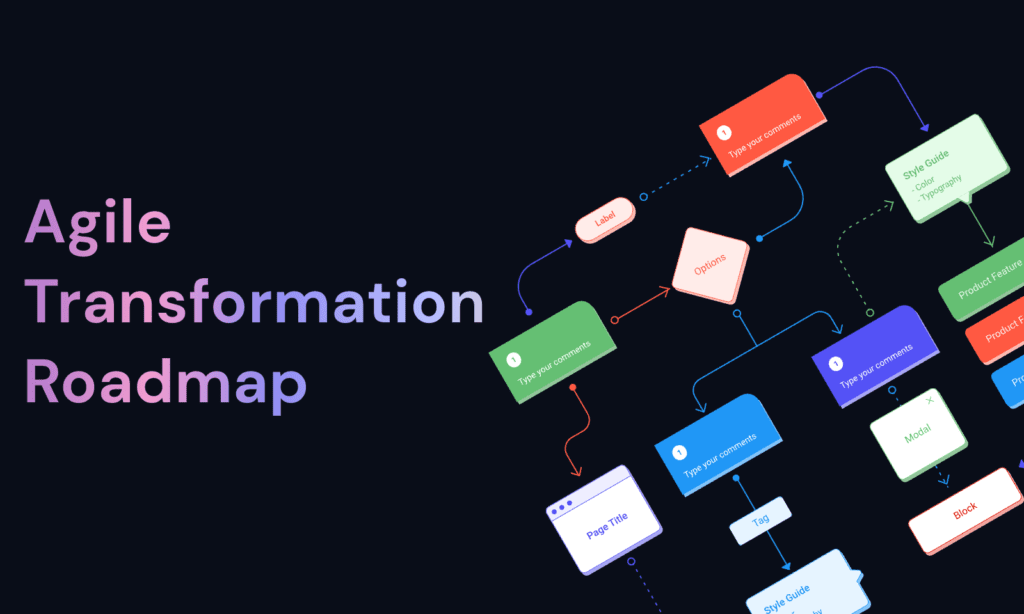Agile transformation is a profound shift in business approach, prioritizing people, collaboration, and customer feedback over rigid processes. It involves breaking projects into smaller segments for quicker and more precise task handling. Establishing an Agile transformation roadmap is crucial for structured change, embracing iterative improvement and regular reflection. Initially rooted in software development, Agile principles extend to various business domains, necessitating a significant cultural transformation. Organizations must prioritize adaptability and customer-centricity as core company values to embrace this new paradigm effectively.
Strategic Planning for Agile Transformation
The inception of Agile transformation is often found in strategic planning — a process that involves a dedication to change at the executive level, where leaders become ambassadors of agility. This might look like developing a roadmap outlining the strategic direction and vision and communicating it clearly across the organization. Ensuring the agile transformation roadmap is flexible to changes yet detailed enough to provide assurance and clarity is an art. Targeted efforts by management to foster initiatives that promote the Agile mindset across all levels can lead to a more meaningful transformation. The role of leadership in Agile adoption cannot be overstated. A committed leadership team is crucial in guiding the organization through adoption. Leaders must not only espouse the values of Agile but also demonstrate them in action. With the support and example set by leadership, Agile transformations can succeed, and there needs to be more direction and commitment.
Cultivating an Agile Mindset
To truly thrive in an Agile transformation, organizations must cultivate a mindset that supports the Agile philosophy, embraces change, values collaboration, and strives for continual improvement. Empowering employees through training and education initiatives can equip them with the skills and confidence to contribute effectively. Supporting a culture that encourages taking calculated risks and learning from successes and failures creates an environment conducive to innovation and agility. It’s not just about changing processes but nurturing a cultural shift that transforms how employees think about their work and roles within the organization. This paradigm shift is essential for breaking down barriers and fostering an atmosphere where new ideas can be tested and applied swiftly, without the encumbrance of unwieldy protocols or fear of failure.
Practical Solutions to Agile Challenges
One effective strategy in combating Agile challenges is customizing the Agile framework to fit an organization’s unique context. This involves identifying the company’s particular obstacles and adapting Agile practices to address them directly. It may mean modifying Agile ceremonies or artifacts to serve better the organization’s goals, culture, and operational rhythm. Embracing flexibility and adaptation in this way can lead to a more fitting and sustainable Agile transition. As the modern workplace evolves, managing distributed teams has become a norm — and a challenge — in Agile adoption. Organizational leaders must ensure clear communication channels and foster a sense of trust and common purpose across geographically dispersed teams. Incorporating the right mix of synchronous and asynchronous communication, leading with empathy, and maintaining a high level of transparency can smooth out the rough edges of distributed team management.
Integrating Tools and Technologies
Tools and technologies are critical enablers in an Agile transformation, providing the scaffolding that supports new working methods. Organizations can alleviate administrative burdens and create a more fluid work environment by integrating systems that promote automation, collaboration, and communication. Today, many Agile tools facilitate various aspects of an Agile iteration — from backlog refinement and sprint planning to review and retrospectives. Choosing tools that are not only powerful but also intuitive and accessible can be a deciding factor in how smoothly an Agile transformation progresses. Decisions around technology should consider the organization’s specific needs, the comfort level of its employees, and the nature of its projects.
Measuring Agile Success
Understanding how to measure the efficacy of an Agile transformation is central to its long-term success. These metrics vary widely, from quantitative data like delivery speed and defect rates to qualitative assessments such as team morale and customer satisfaction. A focused approach to performance metrics ensures that teams are aligned with the Agile goals and are making continual progress. Regular check-ins and iterative assessments can help teams remain on track and quickly identify areas for adjustment. By emphasizing a culture of feedback and learning, Agile organizations can refine their methodologies and optimize their workflows, ensuring they continually enhance their agility and capacity to promptly deliver exceptional value to customers.
Future of Agile: Trends and Predictions
The Agile framework is not static; it constantly evolves and is influenced by emerging technologies, industry trends, and organizational learning. Anticipating the trajectory of Agile practices is crucial for companies looking to stay ahead of the curve. Integrating Agile with other methodologies like DevOps, Lean Manufacturing, and Design Thinking indicates a broader trend toward holistic, systems-thinking approaches. Firms that can harness these trends and anticipate future shifts are likely well-positioned to adapt to changing market demands and customer expectations. Such forward-looking agility is becoming an indispensable asset in a business landscape characterized by unprecedented rates of change and complexity.
Conclusion: Embracing Change with Agile
Ultimately, the true mark of an Agile transformation’s success is the ability to navigate change with grace and efficacy. An effective Agile transformation involves far-reaching shifts in an organization’s culture, processes, and mindset. The journey requires planning, leadership, and a dedication to continuous improvement and learning. Companies embracing Agile are changing their workflow and reshaping their organizational identity, embedding flexibility and responsiveness at their core. Organizations can transform the challenge of change into an opportunity by harnessing the principles of Agile. The lessons from successful case studies and an awareness of future trends equip businesses to sail the tumultuous waters of modern industry dynamics confidently. With the right approach, tools, and leadership, Agile transformation can revolutionize how organizations deliver value and maintain their competitive edge in a rapidly evolving market.


